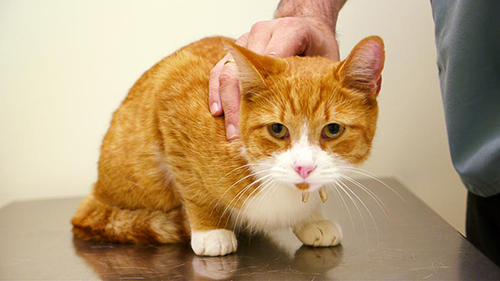
Sometimes it’s difficult to identify when your cat’s not feeling well. Watch for these signs of illness, and consult with your veterinarian as soon as possible if your pet begins to show any of them.
1. Inappropriate elimination
A cat that urinates inappropriately could have any number of conditions associated with the behavior, including lower urinary tract disease, kidney disease, urinary tract infection, and diabetes mellitus. It can also be a sign of arthritis, which makes it difficult for cats to get into the litter box.
2. Changes in interaction
Cats are social animals, so changes in interactions with humans or pets can signal disease, fear, anxiety, or pain.
3. Changes in activity
A decrease in activity is often a sign of arthritis or systemic illness, while an increase in activity can be
caused by hyperthyroidism.
4. Changes in sleeping habits
If your cat is sleeping more than normal (keepnin mind that average adult cats may sleep 16 to 18
hours a day—though much of that is “catnapping”), it could be a sign of an underlying disease.
5. Changes in food and water consumption
Most cats are not finicky eaters. Decreased food intake can be a sign of several disorders, ranging from poor dental health to cancer. Increased food consumption can be caused by diabetes mellitus, hyperthyroidism, or other health problems.
6. Unexplained weight loss or gain
Sudden weight loss can be a sign of hyperthyroidism, diabetes mellitus, or a host of other diseases. Obesity, on the other hand, can cause an increased risk of diabetes mellitus, joint disease, and other problems.
7. Changes in grooming
Patches of hair loss or a greasy or matted appearance can signal an underlying disease. Cats who have difficulty grooming often suffer from fear, anxiety, obesity, or other illnesses. An increase in grooming
may signal a skin problem.
8. Signs of stress
Stressed cats may exhibit signs of depression, hide more, or spend more time awake and scanning
their environment. These signs may indicate a medical condition, so it’s important to rule out physical ailments before addressing the stress behaviorally.
9. Changes in vocalization
An increase in vocalization or howling is often seen with an underlying condition like hyperthyroidism
or high blood pressure. Many cats also vocalize more if they’re in pain or anxious.
10. Bad breath
Bad breath is an early indicator of an oral problem—studies have shown that 70 percent of cats have gum disease as early as age 3.
